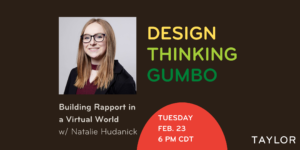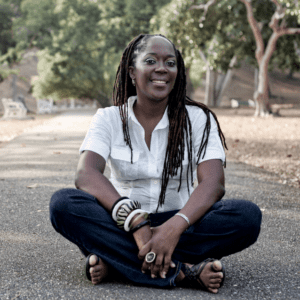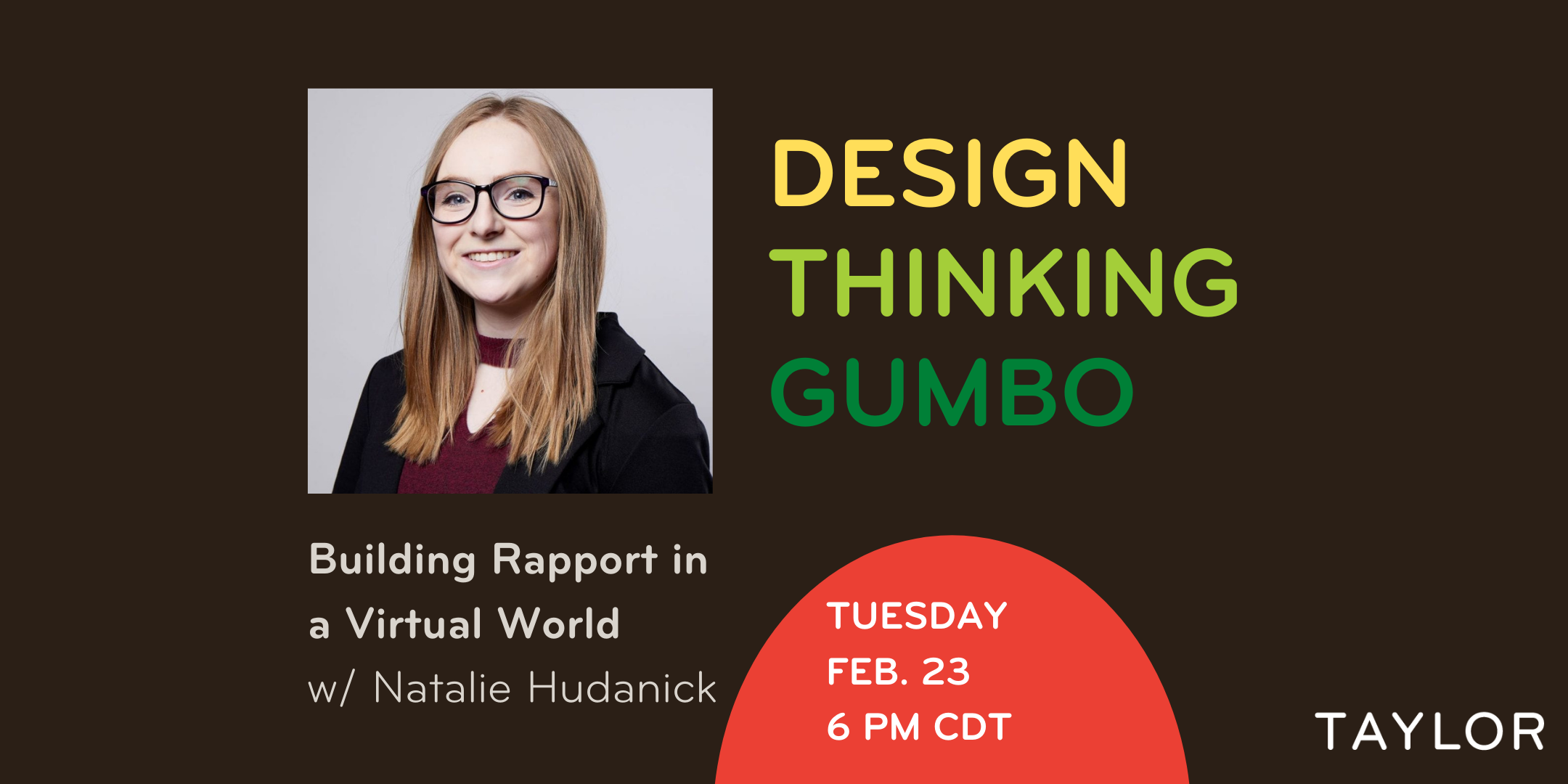
February 23, 2021, 6 – 7 pm
Building rapport in a virtual world gives you the tools to develop rapport and empathy quickly in a virtual and remote setting. The goal of this workshop was to learn not only general, in-person, pre-pandemic rapport building strategies, but also how to adapt these strategies to adjust for virtual and socially distanced in-person meetings/interviews.
Overview
The workshop started with a warm-up on developing empathy, helping to create connections among the workshop participants. After a lecture on rapport, general strategies for building rapport, the role of rapport in design thinking, and adapted strategies for virtual and socially distanced environments, participants went into breakout rooms for two activities.
The first activity was about “breaking the ice” with another person. The goal was to learn about the other person’s expertise that they may have gained during the Covid-19 pandemic. This activity was meant to quickly break the ice between two strangers, allowing small talk to drive the conversation for a few minutes (small talk is a key strategy for building rapport quickly).
The second activity had participants diving in deep to get to know the other person intimately enough to “create” a 2-minute movie of their life. Both activities were one-on-one interviews and followed a plan in for how to develop virtual rapport quickly, starting with easy, small talk-like conversation, and then moving on to deeper, more intimate conversations, ultimately building that trust and respect that rapport calls for in a shorter time span: less than 20 minutes.
Virtual and socially distanced meetings/interviews call for their own strategies to get to know people. Rapport building is critical for successful collaborations in any format, so knowing how to build it quickly, virtually, is important in our current environment.
About the Presenters

Natalie Hudanick is a Graduate Assistant in Design Thinking for Social Impact at the Phyllis M. Taylor Center. She is also is a second-year MPH candidate in Maternal and Child Health at Tulane University School of Public Health and Tropical Medicine. Natalie earned a Bachelor of Science in Cultural Anthropology from Ball State University in Muncie, Indiana. With a background in anthropology and women’s health, her research interests lie in reproductive health and health communication.

Lesley-Ann Noel, Ph.D. is an Afro-Trinidadian design educator, based in New Orleans. In my work, I focus on equity, social justice and the experiences of people who are often excluded from design research. My doctoral research focused on emancipatory design thinking at a rural primary school in Trinidad and Tobago. I also attempt to promote a greater critical awareness among designers and design students. Deep empathy is a key theme in my classes, where students build relationships across difference before collaborating on design with community partners. My research also highlights the work of designers outside of Europe and North America. My identity is shaped by my ethnic background as an Afro-Trinidadian; my experience as a daughter, sister and mother; and my lived experiences in Trinidad and Tobago, Brazil, Tanzania, Uganda and the USA.
Workshop Information
Workshop Recording
Script
DT Gumbo Intro: 2 minutes
Lesley: Hello everyone, welcome you all to the first in the series of Design Thinking Gumbo, a series where we share with you a delicious mix of design research tools and methods, to help you expand your taste for design thinking and design research. I am Lesley-Ann Noel, and I’m the Associate Director of Design Thinking for Social Impact of the Phyllis M. Taylor Center for Social Innovation and Design Thinking. DT Gumbo is led by our design thinking graduate assistants. We will have 5 research workshops over the next few weeks. We’ll post all of the registration links in the chat, but the next workshop……
Natalie: Hi Everyone! My name is Natalie Hudanick and I am a graduate assistant for design thinking for social impact here at the Taylor Center. I am also second year Master of Public Health candidate at Tulane’s School of Public Health and Tropical Medicine.
What’s the session about?
Natalie: The Covid-19 pandemic has created the unique opportunity to explore the application of design thinking methods in a remote and virtual way. This Design Thinking Gumbo session will explore how to build rapport virtually. I do want to let everyone know that this session will be recorded and we will be taking screenshots to feature on the Taylor Center website.
Warm Up: 9 minutes
Natalie: I’d like for us to warm up today by playing a little empathy game. Starting with one person, you will say something about yourself, like a fun fact, a hobby, activity you like, tv or movie you really like, sports, etc. If another person has something in common with what the person said, you can unmute yourself saying “connection!” The first person to say connection, then is virtually “linked” or connected to the original speaker. The person who said connection first is then the next to say a different thing about themselves until someone else makes a connection and so on until we are all linked, creating a “circle”. Once you are connected to someone, please use the “Raise hand” emoji so we know who is connected and who isn’t.
Lecture on Rapport: 12 minutes
Natalie: To start our workshop today, I’m going to first give some background on rapport before moving on to some general rapport building strategies, and then eventually talk about new strategies to adapt rapport building to our current environment.
Rapport can be defined in many different ways, but the way I’m going to define it is a culmination of a few definitions. I’m defining rapport as “making a connection, a relationship, a pathway between individuals to serve the purpose of sharing ideas, beliefs, and knowledge. Ultimately working to create trust, respect, and reciprocity with each other”.
While, in a sense, we typically use rapport in some way when we meet people, trying to make friends, or just to get to know someone in general, rapport itself has professionally been used in the social sciences, specifically anthropology, for qualitative research. Anthropologists doing ethnographic research, especially participant observation and/or interviews, use rapport to establish trust with informants. When doing research, establishing rapport can take upwards of months. But outside of research and academia, you don’t have months to build rapport.
Rapport is important because it helps to establish trust, empathy, friendship that are critical for successful collaborations with others. This trust is essential to making sure that the person you are talking to is comfortable to speak to you about their experiences, their lives, their problems without fear of judgement. Rapport also helps to elevate the person you are talking with to an expert role, making it known that you care and respect their expertise. Your interviewee is the expert on whatever you are talking about with them, especially in terms of qualitative research, so as the interviewer, you want the other person to share their expertise.
In pre-pandemic communication and face-to-face meetings, when we normally build rapport, both verbal and nonverbal strategies play an important role. For our verbal strategies, the initial small talk before moving on to deeper topics can help to establish the tone of the conversation (1). This small talk should be focused on getting the person you are talking to be more comfortable, especially if you’ve never met before. Talking about food, the weather, work, etc. can help to break the ice just a little bit before diving into the real purpose of the conversation. Your tone of voice is very important. If you have the wrong tone, like a more authoritative tone, your conversation could come off more as an interrogation. While listening may not technically be a verbal tactic, actively listening to what the person says can help you find shared experiences with each other. This can then help you to provide more to the conversation by then talking about what the shared experience is (1)
Nonverbal strategies go hand in hand with the verbal strategies. Typically these strategies involve matching or mirroring the non-verbal signals of the person you are talking to. This includes body position, body movements, and facial expressions (1). Eye contact is key, but some people might not like you making eye-contact too much. Trying to mirror the other person can help to create a sense of comfort for everyone involved, instead of creating a barrier between each other.
So where does rapport fit in to design thinking? Within the design thinking process, which is displayed on the slide, empathy is essential to understanding your user, including their needs and problems, that help in the development of whatever you want to create. But it’s not only empathy for the user, you also have to have an empathetic relationship with your team members, collaborators, etc. For example, if you are brainstorming with others, you have to build rapport for those connections. Empathy and rapport go hand-in-hand! In design though, rapport happens fast. You don’t have months to establish those connections, you might only have hours at most.
So, how has the pandemic affected normal rapport building? The pandemic that has been going on for almost a year now has affected almost every way in which we interact, talk with, and interview people. Most often interviews and meetings are happening over video call, and if we are in person, we are trying to practice social distancing measures, so that means we are usually talking to people in masks, a little bit of ways away from the other person. So how do we navigate these new ways of talking to people?
For Virtual Meetings/interviews or for in-person meetings/interviews with masks different rapport strategies are needed to make sure that you can still adapt to this new environment and still work to build the trust and mutual respect between you and the other person. The pre-pandemic strategies, though, still apply though.
Specifically for meeting or interviewing with someone over video call, keep your video on. When you video is on, people can see your face, and a better connection is possible (2). I know first-hand that not having your video on can make you feel disconnected from the other person, especially if you are the only one who has your video on. The energy you have when talking to another person can determine the outcome of the interaction outcomes. For video calls, you should stay calm yet attentive and have higher energy or try to match the energy of the person you are interviewing (2). Video call fatigue is real, and if you have low energy or show that you just don’t want to be there in that call, the other person may not feel like you care about what they have to say or care about their experiences. With the pandemic, my work as a graduate assistant has become completely remote, so our group of grad assistants and our team leader, Lesley, consistently meet each week over video call. We all typically have higher energy in these calls to show that we care about what we are meeting about, and we almost always have our video’s on. Having our videos on, and having a little higher energy, helped to make talking with each other a bit easier, and we also usually do small-talk at the beginning of each of our meetings to work towards creating connections with each other. Normally eye-contact is important when talking to people, but now it is even more crucial to try to maintain eye-contact as best as possible during video calls, this means trying to make eye-contact into the camera. When you stare more into the camera rather than a the screen, you don’t always look like you are making eye contact, and when we are doing video calls, our screens can become quite distracting, with notifications or we are trying to multitask, which could interrupt the talk you are having with each other, so making sure you stay focused and continually make eye contact will help to make sure that the other person knows you are paying attention to what they have to say. Mirroring is still just as important, and while you can’t mirror the person’s entire body language, you can still mirror what you see in the video call (2). This means mirroring facial expressions, body movements, etc. and, One of the last strategies you can do is to share snippets of encouragement or responses (like repeating what they say) to show the other person you are paying attention and that you are actively listening to them (3).
When talking or meeting with someone in-person, most often we are masked now. Masks and, social distancing in general, pose a few challenges like affecting the volume of your voice, hiding facial expressions, and not being able to shake hands/hug people. Your mask voice is something that you should always be working on. Our voices are often muffled, so you might need to speak up and accentuate what you are saying, but make sure you aren’t shouting though (4). With face masks hiding our facial expressions, we don’t get the opportunity for the other person to see any smiling, or even the questioning face you may make if you are confused by what they are saying or you don’t understand. Smiling with your eyes can help to replace the smile you may normally give when talking to someone, as they most likely won’t be able to see your smile through the mask, and you might want to gesture more than you normally would to help convey any emotion that your face typically displays. If you are the one doing the talking, you may need to take you may need to take longer pauses that give time for the other person to respond because they may not be able to tell through your mask if you are taking a pause in speaking or not. Normally our pauses are short and usually you can tell when someone’s talking if they are stopping for a moment to think (4). Mirroring the body movement’s and body position of the other person is still important, arguably more so now that you may not be able to see facial expressions. And while we may often shake hands or give hugs to the person we may be talking to, proper social distancing makes that almost impossible. So instead, offer a friendly wave at the beginning and at the end, which can still help to set the tone of the meeting or interview. (4)
Keep these rapport building strategies in mind as we work through some activities to help us work on building rapport quickly and virtually. Since we are virtual, we won’t be able to actively work on building rapport while in a mask, but those strategies are still important if you are to meet and get to know someone in person. The following activities we will be doing today will help us first work on “breaking the ice” when meeting someone for the first time, and then working to get to the deep conversations that help you to really connect and establish that rapport.
All the breakout rooms will be the same for the two activities. 2 people in the breakout rooms. Pay attention to cameras are off.
Activity 1: Quarantine Expertise – 7 min – 3 min each person, including introductions – cue in when to switch
For this first activity, we want you to talk about what you may have become an expert in over the last year. Some people became good at baking bread, cooking, sewing, painting, etc. It’s okay if you didn’t become an expert in anything over the last year, instead talk about what you may already be an expert in before the pandemic, and before quarantine even started. The goal of this activity is to share your expertise, and as the in the interviewer, emphasize that you want to understand the other person’s expertise. We are going to put you all into breakout rooms! You will each have 3 minutes to discuss what you are an expert in and be interviewed about that expertise. Remember the techniques I went over: video on, eye contact, mirror body movement/positioning (as much as video allows), stay attentive, and have a little higher energy. Prepare to share out your experiences, at least one person from each group should be prepared to share!
Debrief – 5 min
How was this experience of “breaking the ice”? Describe how you felt talking with the people in your group. what did the other person do to make you feel comfortable?
Activity 2: 10 min – 5 min each – need to cue in during the breakout room when to switch
For our next activity, we actually borrowed this from one of Lesley’s classes here at Tulane. Lesley could you tell us a little bit about this activity in the classroom setting.
Lesley: talks about this activity that she used in class
Since we are completely virtual and do not have that as much time as possible, we have adapted this activity slightly to reflect this. We are going to put you back into your same break out room groups, and this time we want you to guide your interview in a way in which you can understand the other person intimately enough to figure out what you would put in a 2-minute movie about them. How would you go about interviewing to understand the other person’s life intimately enough to describe a short movie about their life, about their experiences? You will each have 5 minutes to be interviewed by the other person in the same breakout rooms you were in before. You are welcome to take notes if you have anything nearby to take notes on! Be prepared to share out about your experience in the breakout room as well as something that you learned about the other person in your breakout room.
Debrief: 8 min
How was it trying to get this information? What was the experience like? Was it a little easier to do this activity within the same breakout room? What if you were in a different breakout room? How do you think that would have impacted your interview/conversation?
Final Debrief: 5 min
As we come to the end of our workshop, I’m going give some final thoughts on rapport building virtually. Outside of research and academia, you don’t have months to build rapport with someone. You have to find those connections, build that trust and respect quickly. The goal of these activities were to show you how to use virtual rapport building strategies to first get past that awkwardness that may come when talking to someone for the first time, and then working to have more intimate conversations in which you can start to create that trust, respect, and ultimate connection that is a part of rapport. Rapport is not easy to build, and it can make or break whether or not you will have a good relationship with that person you are speaking to. So, If you have any questions on what we discussed today or any final thoughts, please feel free to unmute yourself and ask them or just drop them in the chat!
Close Out: 2 min
I just want to say thank you for coming to this workshop! I hope you all were able to get valuable information out of this workshop to use in your own life, any capacity. You can find more resources on design thinking and more information about the Taylor Center at taylor.tulane.edu. We have a design thinking breakfast this friday on the 26th, and we also have our next DT Gumbo on March 1st!
References:
About the Series
Design Thinking (DT) Gumbo is a series of one-hour workshops on a variety of methods that can be used in design research. Each workshop will introduce a method, share examples of its use in other settings, and include space for participants to practice the method together.
- Think of these methods as ingredients to make your design thinking work much more rich and flavorful. Try out the different ingredients and see which ones appeal the most to your palate.
- This semester all of our method workshops will focus on understanding people’s experience of the coronavirus pandemic.
- DT Gumbo is a project of the design thinking program of the Phyllis M. Taylor Center for Social Innovation and Design Thinking at Tulane University.
- All workshops are co-facilitated by Dr. Lesley-Ann Noel and a Taylor Center Design Thinking Graduate Assistant.
